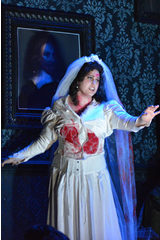| Opera Reviews | 24 April 2024 |
Lucia re-imaginedby Steve Cohen |
|
Donizetti: Lucia di Lammermoor |
|
|
In the novel, Lucie Ashton and the nobly born but now dispossessed Edgar Ravenswood are in love, even though the Ravenswoods and the Ashtons, who now own the former Ravenswood lands, are enemies. In order to save the family from ruin, Lucie is forced to break her engagement to Edgar and marry the wealthy Sir Arthur Bucklaw. The machinations of the feuding clans are given refreshed importance in the staging by Nic Muni. He uses huge tombstones and his dark interiors have walls covered by paintings of ancestral personages. He also changes the normal portrayal of Lucia’s older brother Enrico as the villain for forcing her into a loveless marriage. Muni’s direction reminds us of the family disaster that looms, and makes us understand that Enrico had to pressure his sister. He is a conflicted character, and it’s Arturo who is the real villain, taking advantage of both families and disrespecting Lucia. Small wonder that she stabs him to death on their wedding night. Macatsoris’s musical interpretation is a perfect match with Muni’s. The notes remain the same, but they are in the service of telling a tale that’s much more than a showpiece for voices. His tempi are slower than in past performances: singers and orchestra hold each note fractionally longer than before, so they have more gravity. Nothing is draggy; every moment has urgency. The orchestra sounds darker, with special accentuation from the bassoons and horns. The mad scene (Il dolce suono, spargi d’amaro pianto) soars as it should, but its emphasis is more on drama and less on spectacle. The musical centerpiece in this production becomes the sextet (Chi mi frena in tal momento) before the mad scene, in which each of the characters express their conflicted feelings. Macatsoris has all the participants sing sotto voce, in whispers, because they are reflecting inwardly, not directing their words to any of the other characters. Normally, Lucia does not appear after the mad scene. Edgardo has the last scene to himself and, in the middle of it, he’s told that she has died. Here that final scene is on a divided stage. On the right is Edgardo, on the left is the inside of Lucia’s castle where she lies dying. We see her expire, as Enrico grieves over her body. Edgardo bursts into the room as the curtain falls. In the cast that I saw, Meryl Dominguez was Lucia and Mackenzie Gotcher was Edgardo. Both are relatively new artists at AVA but with solid, mature voices. They were as thrilling as were the leads the last time the company did Lucia, in 2008. That production featured Angela Meade and Michael Fabiano, who are now stars at the Met and worldwide. Baritone Jared Bybee, who has headlined many AVA productions, was an excellent Enrico. Roy Hage, a recent transfer from the Curtis Institute, sang the secondary tenor role of Arturo with a first-class voice. Alternate casts appear during the run of the production. An audio broadcast of this will be streamed by wrti.org on a date to be announced. It’s worth searching for.
|
|
| Text ©
Steve Cohen Photo © Paul Sirochman |

 Gaetano Donizetti’s Lucia di Lammermoor is such an icon of bel canto that we don’t expect to find anything new in it. But conductor Christofer Macatsoris, in the seventh decade of his career, has found a new approach. This interpretation is more aligned with the dark and somber Scottish atmosphere of Sir Walter Scott’s 1819 novel, and less focused on high notes and ornamentation.
Gaetano Donizetti’s Lucia di Lammermoor is such an icon of bel canto that we don’t expect to find anything new in it. But conductor Christofer Macatsoris, in the seventh decade of his career, has found a new approach. This interpretation is more aligned with the dark and somber Scottish atmosphere of Sir Walter Scott’s 1819 novel, and less focused on high notes and ornamentation. 





